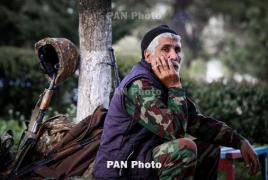One year after the Four-Day War in Karabakh April 2, 2017 - 15:46 AMT PanARMENIAN.Net - One year ago today, in the wee hours of April 2, Azerbaijan launched a large-scale military offensive along the contact line with Artsakh (Nagorno Karabakh). The clashes lasted four days and were later dubbed the Four-Day War or April war. Fighting was especially intense in the southern (Hadrut) and northeastern (Martakert) sections of the frontline. In its large-scale offensive operations, Azerbaijan employed almost all types of military equipment it possessed in its arsenal. Just like the 90s, the Armenian people in Armenia, Artsakh and the Diaspora united to defend Karabakh. A number of events and protest rallies were being organized in various corners of the world, which sought to put an end to Azerbaijan’s aggression against Karabakh. People organized fundraisers and did whatever they they could do to help smooth the situation. To manage irregular cash flows, the Karabakh government opened a special bank account. As a result, around AMD 5.5 billion ($11,4 million) were transferred by 7,903 legal entities and individuals in the period between April 4, 2016 and january 1, 2017. Of particular importance is the major flow of volunteers from Armenia to Artsakh, which included not only Karabakh war veterans but also many young people. Armenian president Serzh Sargsyan met with the OSCE Minsk Group co-chairs on April 4, 2016 to brief them on the situation along the contact line. The Minsk Group, in turn, convened a meeting the next day in Vienna and released a statement afterwards, condemning the military operations in the conflict zone. In Berlin, the then OSCE chairman-in-office Frank-Walter Steinmeier said: “Reports on the cessation of hostilities are encouraging. Our immediate efforts must now focus on stabilizing the ceasefire and preventing any new escalation. Hostilities must stop in an effective and lasting way. In this regard, I welcome the early visit of the co-chairs to the region. I remain in close contact with the sides and other international actors.” As a result, an agreement on the cessation of hostilities was reached four days after Azerbaijan’s attack, on April 5. In the days that followed, the agreement was chiefly observed, although Azerbaijan initiated unsuccessful subversive attacks. In the four bloody days of April last year, both Armenian and Azerbaijani sides suffered major manpower and equipment losses, with several citizens, including a child, killed in Karabakh. The number of state universities will be reduced from 23 to 8 by 2030, Minister of Education, Science, Culture and Sport Zhanna Andreasyan has said. From September 21 to November 11, a total of 2,820 Russians registered at a place of residence in Armenia, the police has said. The situation on the contact line between Karabakh and Azerbaijan was relatively stable overnight, the Defense Army says. Defense Minister Suren Papikyan has visited the southern Armenian province of Syunik, the Defense Ministry reported on March 18. Partner news |